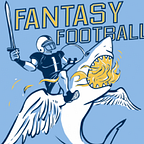NFL Deadzone: The Pit of Mediocrity
“If you ain’t first, you’re last.” — Ricky Bobby, Talledega Nights
The NFL, more than any other professional sports league, prides itself on creating “parity”. It is ingrained in how the NFL conducts designs each season, from the draft to the schedule. In the NFL, the best picks in the draft go to the worst teams. There is no lottery that could potentially reward a good team and punish a bad one. Additionally, the schedule formula places a team against four opponents of similar division standing from the previous season (i.e., whatever team finishes first in the AFC East plays all other AFC division winners, and an NFC division winner). If there were true parity in the NFL, there would also be ‘mobility’, or teams rising and falling through the standings at a reasonable rate. Unfortunately, that’s not the reality.
Stability of Standings
By looking through the past ten years of teams’ win-loss records (2012–2021), it is clear that most often, good teams stay good, mediocre teams stay mediocre, and bad teams stay bad. For this analysis, good teams are those with ten or more wins, mediocre teams with between seven and nine wins, and bad teams with six or fewer wins.
Between 2012 and 2021 there were 96 good teams, 101 mediocre teams, and 91 bad teams. More than half of each group stayed in their group the following season (see table below).
One year
It is more common for mediocre teams to become bad than it is for them to become good. And it is more common for bad teams to become mediocre than good. The result is an endless spin-cycle of teams trying and failing to meaningfully improve.
While one year may not be enough to turn around an NFL franchise things don’t really improve over two years:
Two years
Interestingly, over two years, mediocre teams are more likely to become bad than they are to stay mediocre. On the bright side, it becomes slightly more likely that they become good teams over two years than in one year.
So if that extra year starts to improve upward mobility for mediocre teams, then three years must really do the trick…
Three years
Not exactly. Over three years things start to revert back to what was observed over one year. The most notable change over three years is that bad teams are more likely to become mediocre teams over that time.
The story here is that upward mobility for mediocre, and bad teams is nearly impossible. Good teams have a stranglehold on their standing over one, two, and three-year time horizons. The NFL’s attempt for parity has not resulted in mobility.
So how do teams become good?
The Standings Boosters
While bad teams typically stay bad, and mediocre teams typically stay mediocre, there are plenty of examples of teams (88 teams) that were bad or mediocre and became good in the following season.
As is the case with most football analyses, the answer comes down to the quarterback. Between 2018 and 2021 there were 20 teams that went from mediocre or bad to good. Of those 20 teams, 10 started a new quarterback or had their starting quarterback return from injury.
For teams that became good and did not make a change at quarterback, adding a new head coach or new offensive coaching staff were notable additions. (While 20% of teams added a new HC, and 10% of teams added only a new OC, one of those teams also had a QB return from injury.)
For teams that did not make a notable change at quarterback, head coach, or offensive coordinator, the reason for their success was less clear.
Team Development
A quarter of teams that became good after a season of mediocrity or worse between 2018 and 2021 had no readily explainable reason. These teams include the 2019 Bills, the 2020 Rams, and the 2021 Cardinals (among others).
The 2019 Bills season was the beginning of Josh Allen’s ascension to superstardom. The 2020 Rams recovered from a dismal 2019 by having Sean McVay reinvent the offense that had been ‘figured out’ after the 2018 Super Bowl loss. The 2021 Cardinals' success came from MVP-caliber performances from second-year QB, Kyler Murray, over the first half of the year. While these teams can’t be grouped together as easily as those who started a new QB, their success came from a strong foundation that was enhanced by free agent and draft additions.
In Conclusion
While there may not be the desired mobility the NFL wants to see, the foundations for parity in the NFL are sound. Bad teams get access to the best quarterbacks in the draft, which, in turn, is the surest way to become a good team. However, bad teams are bad because they make bad decisions. And so they tend to keep themselves at the bottom.
However, being bad sparks change. And that change can mean finding a new coach, OC, or taking a shot on a new quarterback in the draft and hopefully getting lucky.
For mediocre teams, there is no such hope. There is no number-one overall draft pick coming to save the franchise. There is no definitive answer on whether the coach is still cut out for the job. There is only waiting, and plodding along in mediocrity.
So if this wasn’t your team’s year hopefully they were bad enough to be good someday. Because if they were just OK, you better hope they suck next year.
